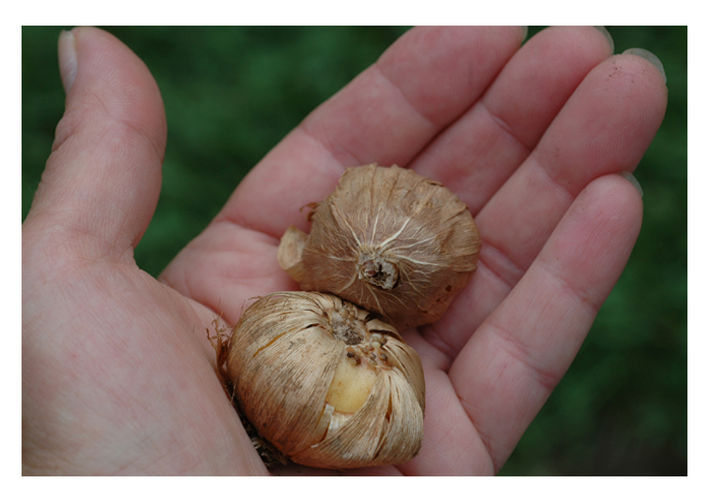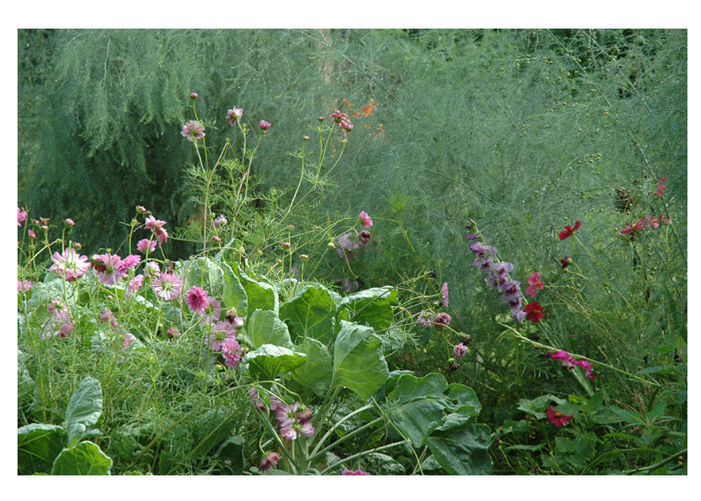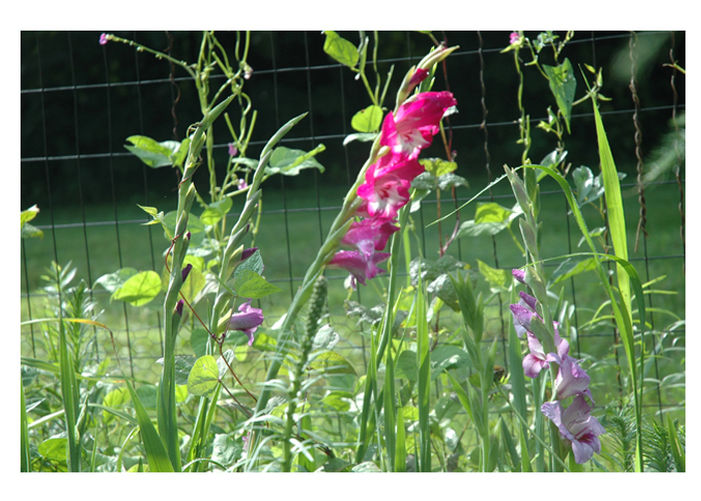MINI GLADS MINGLE WITH VEGGIES
by Tovah Martin
Glads sometimes get a bad rap. Quite honestly, I never could fathom why these infinitely happy flowers were snubbed just because they cheer people up when they are in mourning. The only problem that I have with glads is their height—which makes them tough to integrate seamlessly into a garden. So when Longfield Gardens offered the shorter Sunset Glamini Blend, I jumped for it.
And I saw no reason why I should keep these glads from mingling with the rest of the scene here. I’ve always been a strong advocate for blurring the lines between gardens. Why should vegetables be kept separate from blossoms? Granted, it’s tricky to merge perennials into a garden that is replanted frequently throughout the season. But annual bulbs seem like a natural for the job of joining flowers and food. The mini glads are particularly apropos.
THE CONCEPT:Let’s face it, the vegetable garden could use a little brightening up. Asparagus is all well and good, but why not tuck in some bulbs between its shoots to everyone’s benefit? I happen to have a large, round vegetable garden surrounded by a ring of asparagus. When it grows up, the asparagus looks fairly nice—but it could use a little color sprinkled in. THE SOLUTION:
So I decided to partner asparagus and glads, letting them support one another. In midsummer, asparagus needs to be allowed to grow up into its ferny stage and gather energy for the following year. With glads interspersed, it looked like a massive bouquet. Then, to take it one step further, I planted the Glamini Blend in a container of 'Astia' zucchini and they were perfect pot mates. Food for both body and soul.

These are the mini gladiolus bulbs straight from the bag and ready for planting. The lower bulb shows the root end, the upper bulb shows the growing tip that should be planted face-up about 2-3 inches below the soil surface.

By the third week in June, the asparagus are already beginning to shoot up to flower, but the mini glads are also making a presence.

Just to be festive, I added other annuals as well – such as zinnias. The poppies just seeded themselves in.

I planted the mini glads about four inches apart, leaving room for the asparagus to mature. Pole beans have sprouted in the background.

By the end of July, the Glamini glads where beginning to unfurl their flowers at just the right height of approximately 2 to 2 ½ feet. Here’s ‘Nel’, the first to bloom.

Glamini ‘Zoe’ wasn’t far behind. Although Glaminis are shorter than their tall brethren, the flowers are nearly the same size.

Not only did ‘Zoe’ peek out from the asparagus, but the Glaminis frolicked with the other vegetables – like the cucumber climbing alongside.

Between the mini glads and the cosmos, the vegetable garden was anything but boring. Those are Brussels sprouts growing in raised beds alongside.

And that’s ‘Nel’ serving as an accent between the broccoli and the asparagus.

Other colors also added to the festive array. And the scene was so successful that I got an idea = I put in a second planting of Glaminis so that the asparagus would still be looking glam later in the season.

Part of the pleasure of planting a blend is the surprise factor. Who knows what the colors will be? And the Sunset Blend didn’t disappoint—the colors spanned the rainbow.

Each flower stalk was a slight variation on the color theme. So, one stalk of ‘Nel’ had different throat markings from its neighbor—so there was the surprise factor involved. Plus, they would undoubtedly make incredible bouquets—but I decided to leave them in the garden.

Although I planted another wave of Glaminis, my first planting kept on coming for a long duration of time, here’s a stalk of ‘Nel’ just budded when the rest of the planting had been flowering for a while.

To make a festive sight more flamboyant, I planted red Cosmos ‘Rubenza’ to pick up the throat markings in ‘Nel’.

For glads to make a statement, you need a lot of bulbs clustered together. Here are all the colors of the blend on stage together.

All the vegetables enjoyed the collaboration – in fact, the pole beans fell in love with the Glaminis.

As a bonus, I planted some Glaminis in a wide terra cotta container with ‘Astia’ zucchinis—specially bred for container growing. The zucchinis supported the mini-glads from the beginning.


